The second day I spent in Greece with a group of bird lovers started by our going for a pleasant walk around a smaller section of the Evros Delta National Park in order to watch birds there, bearing in mind the wealth of the avian world of this area. As I’ve already described in the previous sequel of my travel stories, the walk took us to the seashore and then we returned to the coach and simply continued on to Bulgaria. The plan was to go to the town of Madzharovo where we had a reservation for one night and to the village of Studen Kladenets where we were to watch birds again.
The whole group was in a good mood and apart from the occasional chatting with my friend Sonja and the neighbours from the coach, from time to time I also took photos of the landscapes we passed through.
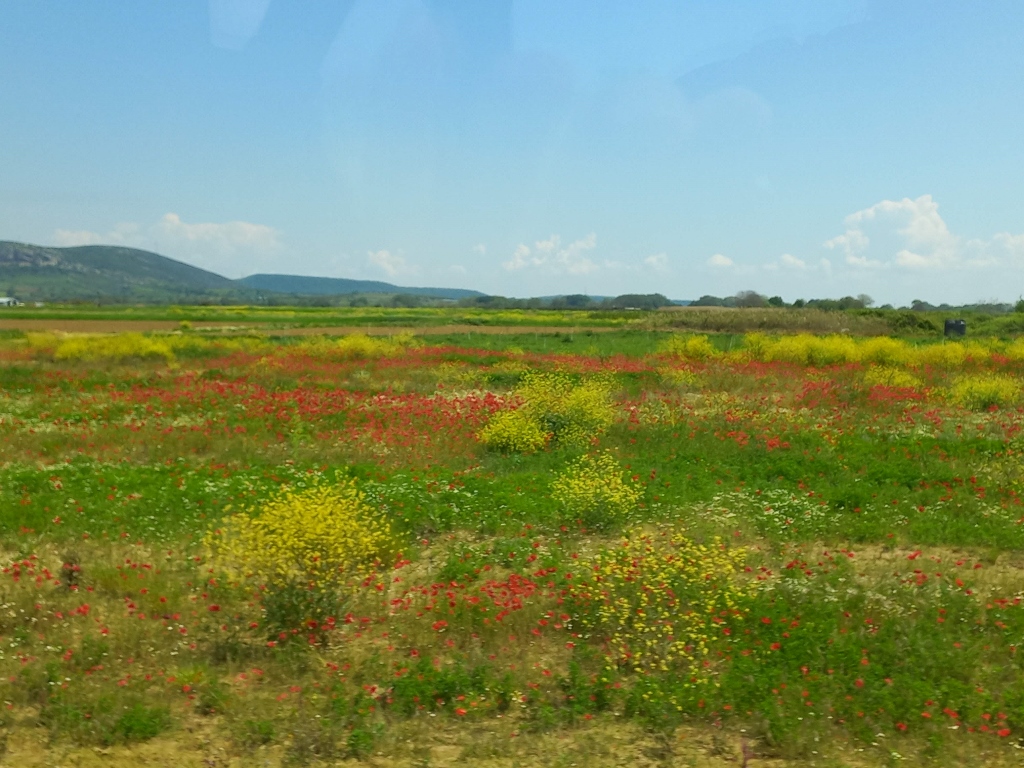 Spring version of a meadow by the road in east Greece
Spring version of a meadow by the road in east Greece
The shortest and the most logical route was to go back westwards along the coast for a while and then to head directly northwards towards Bulgaria. The road started to ascend at some point since the border crossing between Greece and Bulgaria here is in the mountains at around 900 m a.s.l. The surrounding landscapes were splendid.
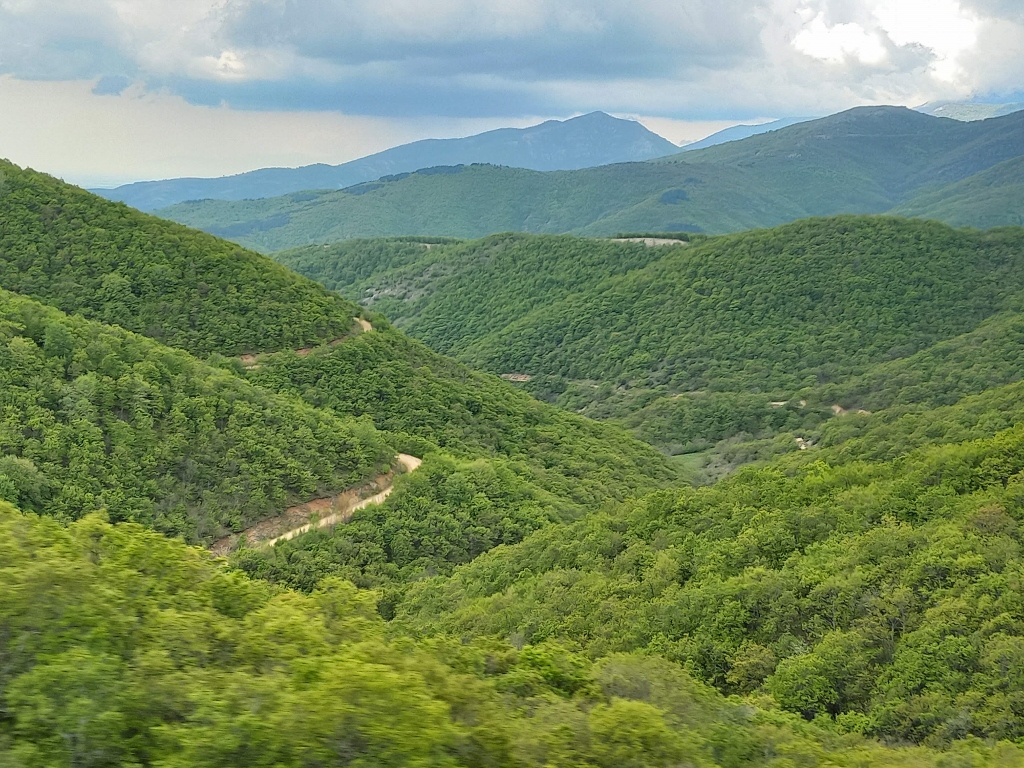 Mountains in east Greece
Mountains in east Greece
We got to the border crossing and there we came across a surprise. We were told that the crossing was not envisaged for vehicles exceeding 3.5 t of weight. We had not seen anything along the way that would suggest this and according to what I could see on a Google map, there is a clear lane for trucks (carrying the TIR plate), but this was what we were told and there was no solution but for the coach to turn and head back.
The organisers of the trip decided that we should go to another border crossing between Greece and Bulgaria, and this was in the far northeast of Greece. We drove past Alexandroupoli again, as well as by an exit leading to the Dadia-Lefkimi-Soufli Forest National Park, continuing farther to the north.
I kept on paying attention to the landscapes we were driving by and I also occasionally took photos. The day was beautiful and I thoroughly enjoyed.
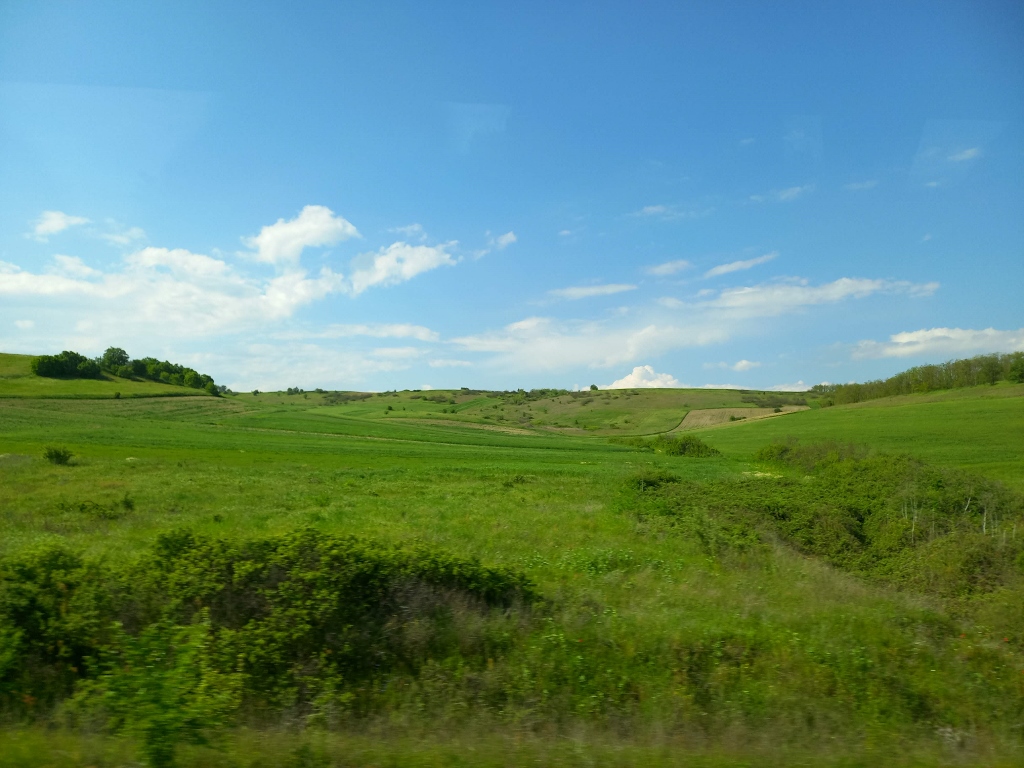 Landscapes by the road in the far east of Greece
Landscapes by the road in the far east of Greece
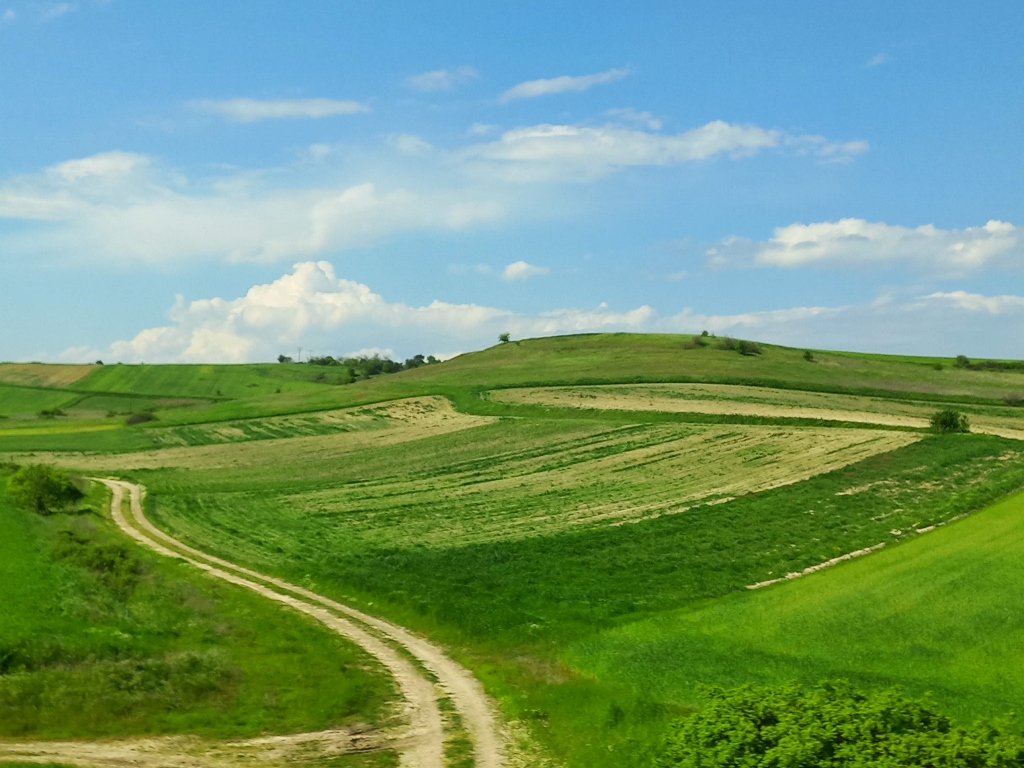 Landscapes by the road in the far east of Greece
Landscapes by the road in the far east of Greece
And so we got to a new border crossing between Greece and Bulgaria, but there was yet another surprise for us there. As it turned out, some kind of net was down at the Greek side of the crossing and the authorities from Athens ordered that nobody who was not from the European Union could pass. I beg your pardon???!!!
Apparently, the repair workers had started to deal with the problem already four hours earlier, but it was a holiday and we realised the chances of having anything repaired on this day were minimal.
The idea to go back again all the way to the west, to the border crossing with Bulgaria where we entered Greece did exist as a realistic option, but that also meant that the visit in Bulgaria would be completely out of question. Namely, that border crossing was around 450 km away at this moment. If we were go to there, the only reasonable thing to do would be simply to continue back home and nobody really liked the idea.
Thanks to a creative approach to the solving of the newly-arisen problem, the organisers of the trip realised that we were in fact quite close to the Turkish border. We asked the people on this Greek border crossing where we were stuck to check if the net was functional at the other crossing leading to Turkiye and they very kindly obliged, even confirming that they “announced” our arrival to their colleagues.
So, the crazy adventure could start.
Thus we returned for some 30 km and after the border formalities crossed into Turkiye. From there we had around 20 km to the Turkish-Bulgarian border.
Although it would have been much better if we had crossed into Bulgaria already at the first border crossing of the day (the one in the mountains), I must admit that I did not mind this. After all, the circumstances were such as they were and under those we did come up with the best possible solution. No nervousness on my part would change anything.
On the other hand, I was in no mood to miss out anything, so I keenly followed our route taking some photos along the way. As it turned out, this was almost a sightseeing tour of some parts of Edirne, the famous historical city founded by Roman Emperor Hadrian who the city was named after. Actually, I was just trying hard to see something good in the unfortunate situation.
To start with, we drove along a bridge over the Maritsa river. Because of the bridge fence I could not take nice photos of the river, but I did catch it a little once we had left the bridge.
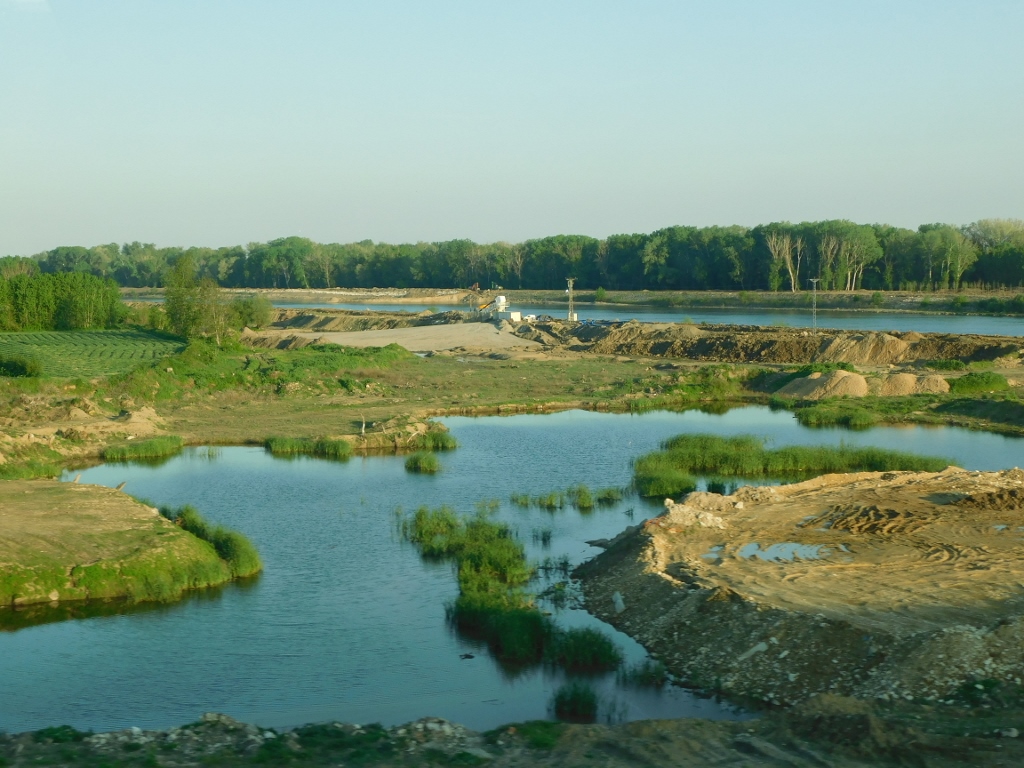 View at the Maritsa close to Edirne
View at the Maritsa close to Edirne
Then the road took us beside Gazi Mihalbey Mosque built in 1422. The mosque has a very nice front facade consisting of five impressive arches and it also has a minaret.
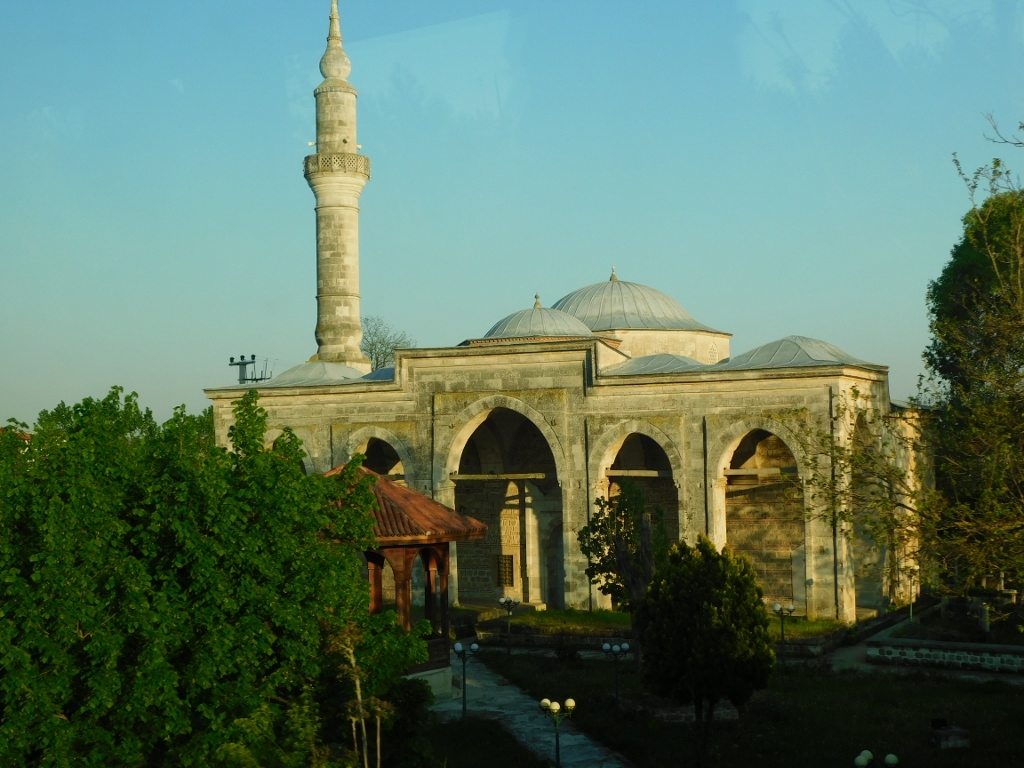 Gazi Mihalbey Mosque in Edirne
Gazi Mihalbey Mosque in Edirne
In the direct vicinity of the mosque there is also Gazi Mihal Bridge that crosses over the Tundzha river. The bridge was originally built by Byzantine Emperor Michael VIII Palaiologos (b. 1224-1282), but it was restored later, in the 15th century, by Turkish Bey Gazi Mihal whom the bridge was named after. In 1544, Turkish Sultan Suleiman the Magnificent (b. 1494-1566) added more spans on the west end of the bridge and this was exactly what I managed to take a photo of.
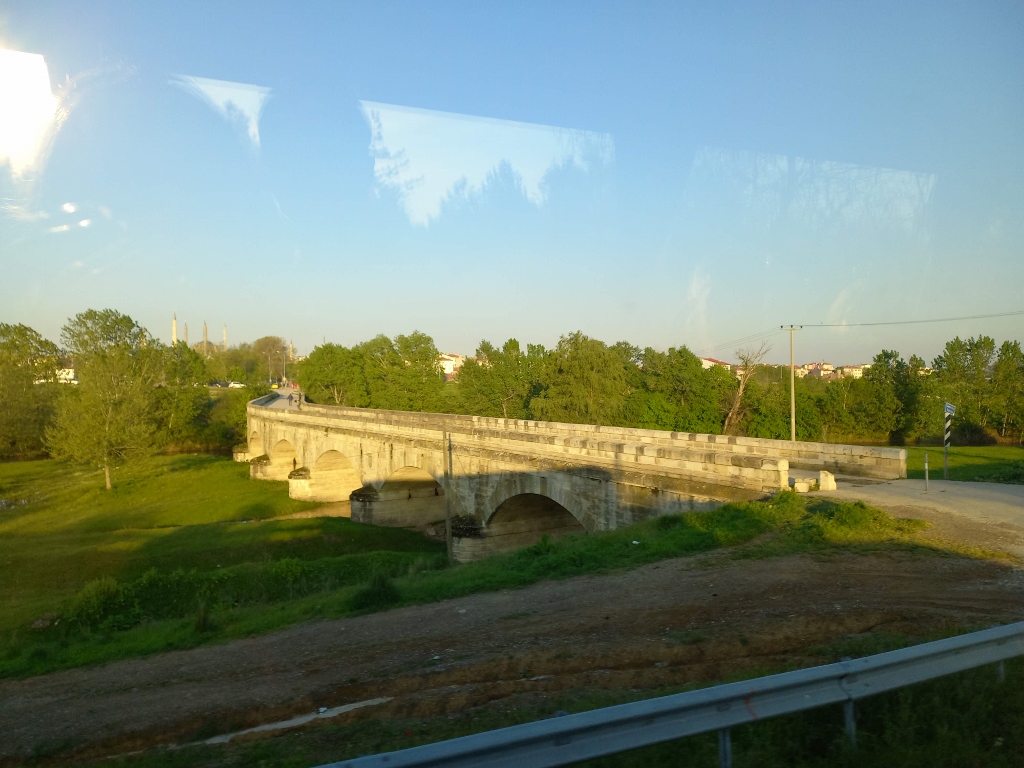 Gazi Mihal Bridge in Edirne
Gazi Mihal Bridge in Edirne
Nowadays, another, contemporary bridge is used to cross over the Tundzha river. There I took a photo of a sign pointing in the direction of Istanbul.
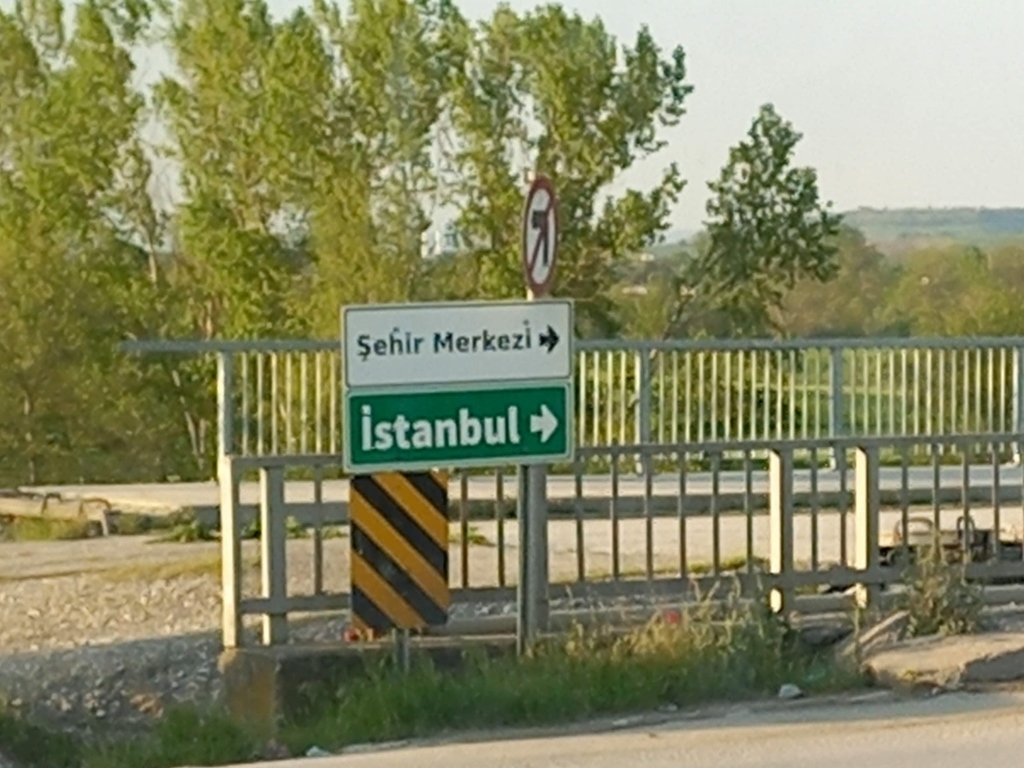 Road to Istanbul
Road to Istanbul
We turned in the completely opposite direction here and that provided me an opportunity to take a photo of as many as two impressive mosques in the centre of Edirne – Burmali Mosque in the foreground and Selimiye Mosque in the background. The latter was designed by the famous Ottoman architect Mimar Sinan (1488/1490-1588) and it is considered his masterpiece and represents one of the most important monuments of Islamic architecture. What I want to say by all of this is that Edirne should be visited with a serious sightseeing plan and not like this – literally along the way.
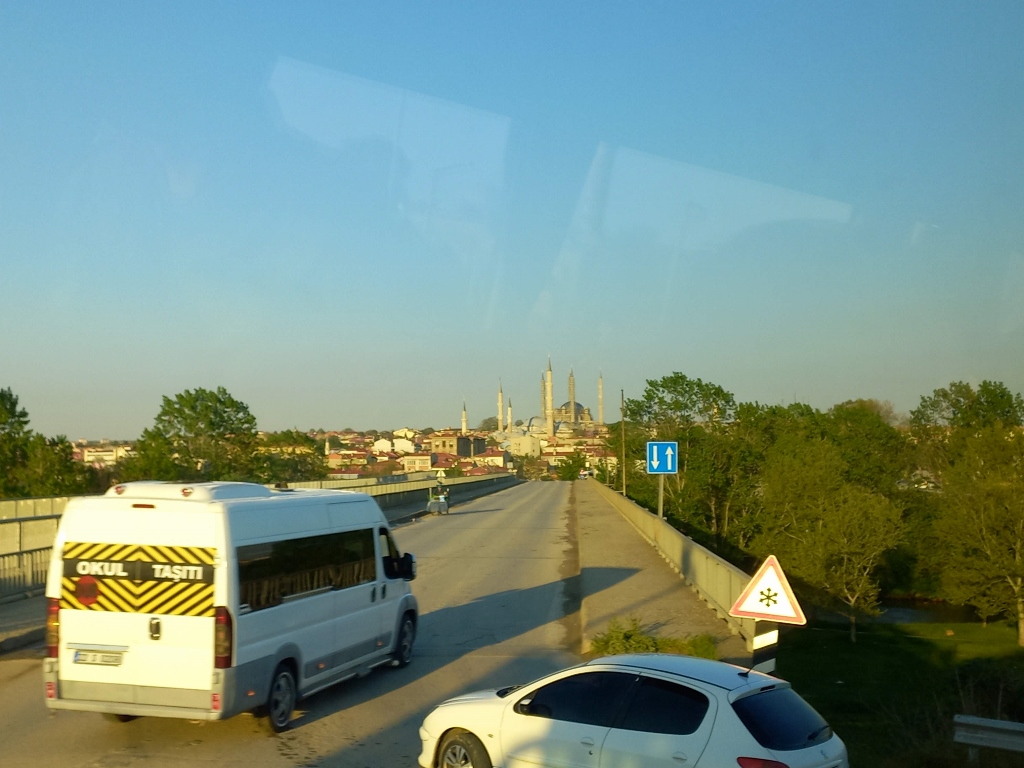 View towards the centre of Edirne
View towards the centre of Edirne
When we got to the border, it turned out there was a line of coaches, so we had to wait a little. A couple of us took the opportunity of the situation and we went back a little on foot in order to buy some food for the entire group, since the trip unexpectedly got too long and it would certainly not be efficient to make another stop somewhere to eat. We have already lost a lot of time.
But, there is never a problem about food in Turkiye. It was improvised, but as far as I could see later on, nobody from the group complained about our choice. Because, what kind of a visit to Turkiye it would be, even if improvised, if there were no – borek and baklava?
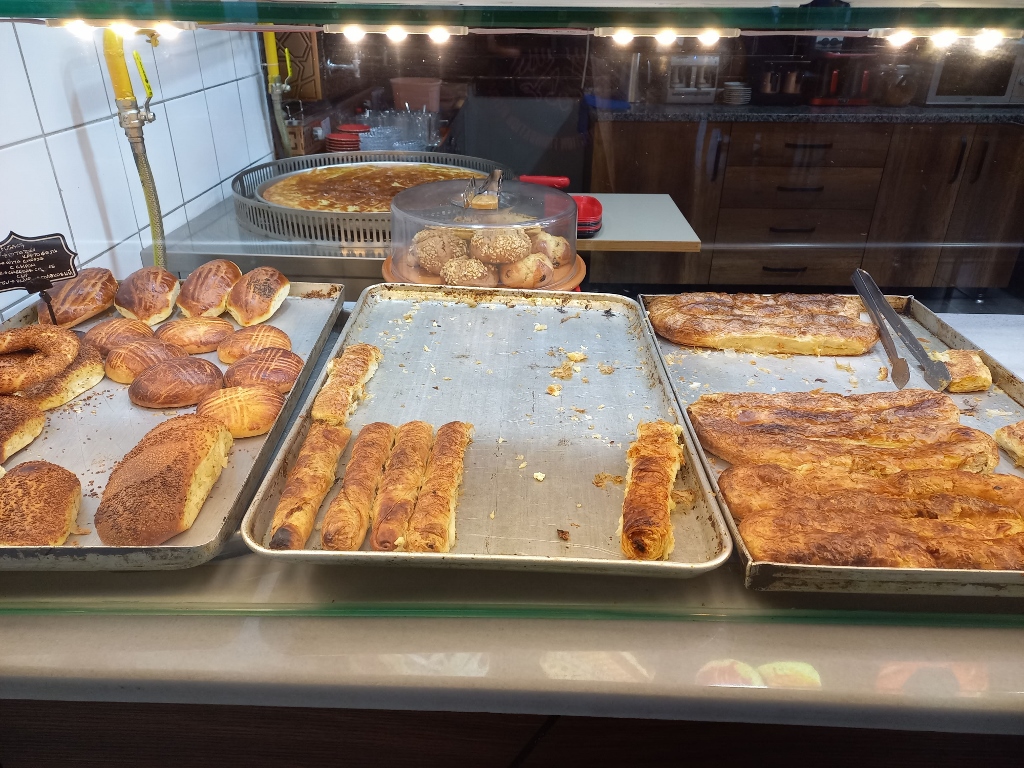 Food in Turkiye
Food in Turkiye
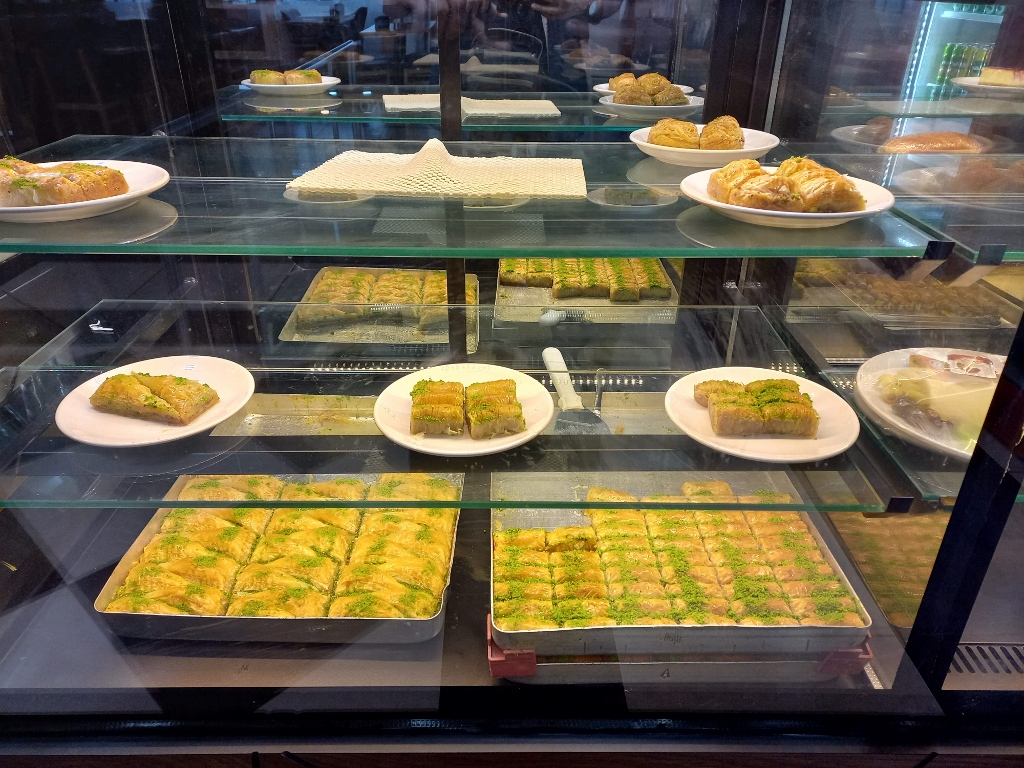 Food in Turkiye
Food in Turkiye
So, after waiting at the border for a while, we finally crossed into Bulgaria and headed for our destination which was the town of Madzharovo. Because of all the driving around the north of Greece from one border crossing to the next, as well as the longer road we had to take because of the circumstances, we lost a lot of time and all the plans linked to bird-watching on this day automatically faded away.
Along the way, we drove for a considerable period of time on some local roads that were not in the best of state and this was all in pitch black, but I could still see woods we were driving through along that narrow road. I was truly impressed by the patience and skills of our coach drivers with whom throughout the entire trip we had a very cordial and friendly relation. The entire group was rather informal and very friendly, mind you, and this also transferred to our relation with the drivers who, for instance, also came along with us on the first day when we walked to the viewpoint in order to see the birds for themselves.
All in all, after the long and, it seemed to me, slightly apprehensive drive during which we literally did not encounter anybody on the road for a couple of hours, we got to Madzharovo, admittedly very late – around midnight. Then we all got our room keys and I fell asleep in no time.
The following morning I woke up sufficiently, but not too early. To start with, I enjoyed the view from the room, mostly because of the incredibly clean air.
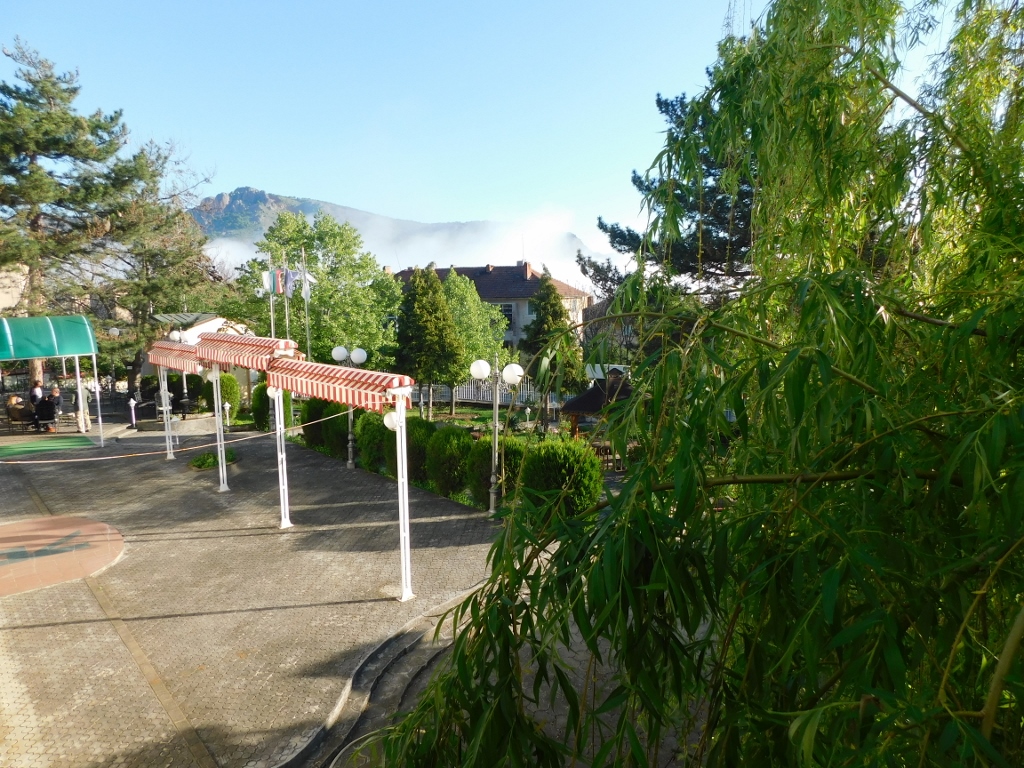 View from the room at a hotel in Madzharovo
View from the room at a hotel in Madzharovo
Because of the changes in the plans on the previous day, the idea to go to Studen Kladenets was given up on and I also did not have enough time to walk around Madzharovo. Well, you cannot have it all.
Following the breakfast we all got into the coach and then drove to a clearing beside the road in front of a bridge over the Arda river. To start with, I walked to the bridge and took photos of the surroundings from there. The landscapes were stunning.
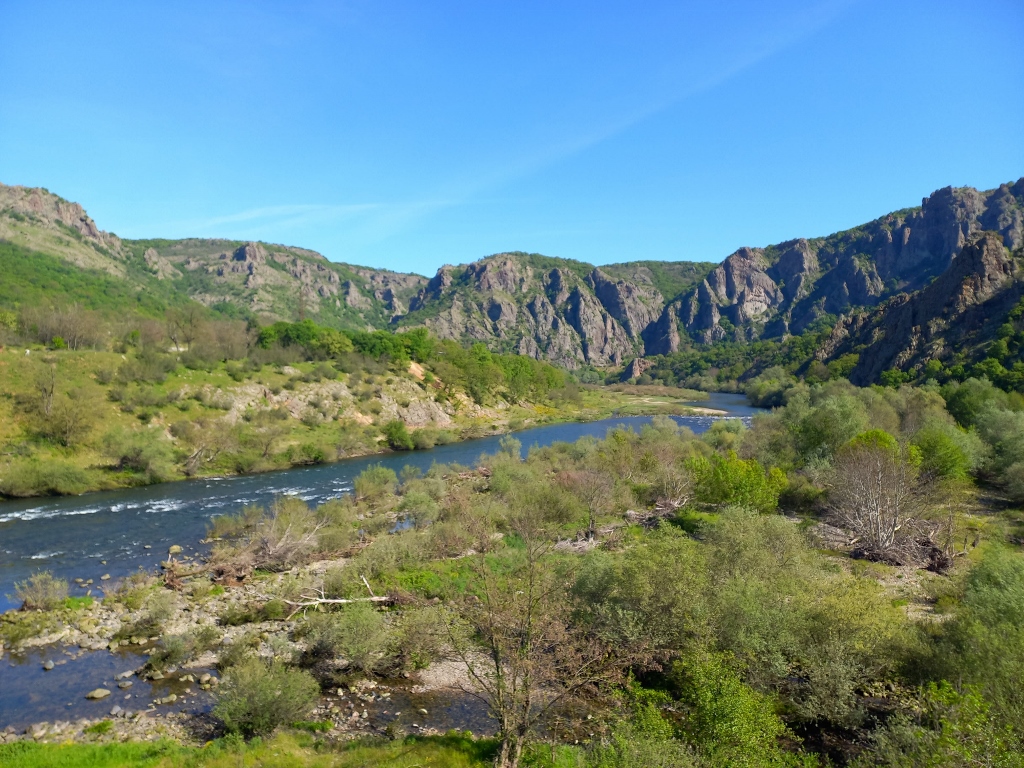 View from the bridge over the Arda river
View from the bridge over the Arda river
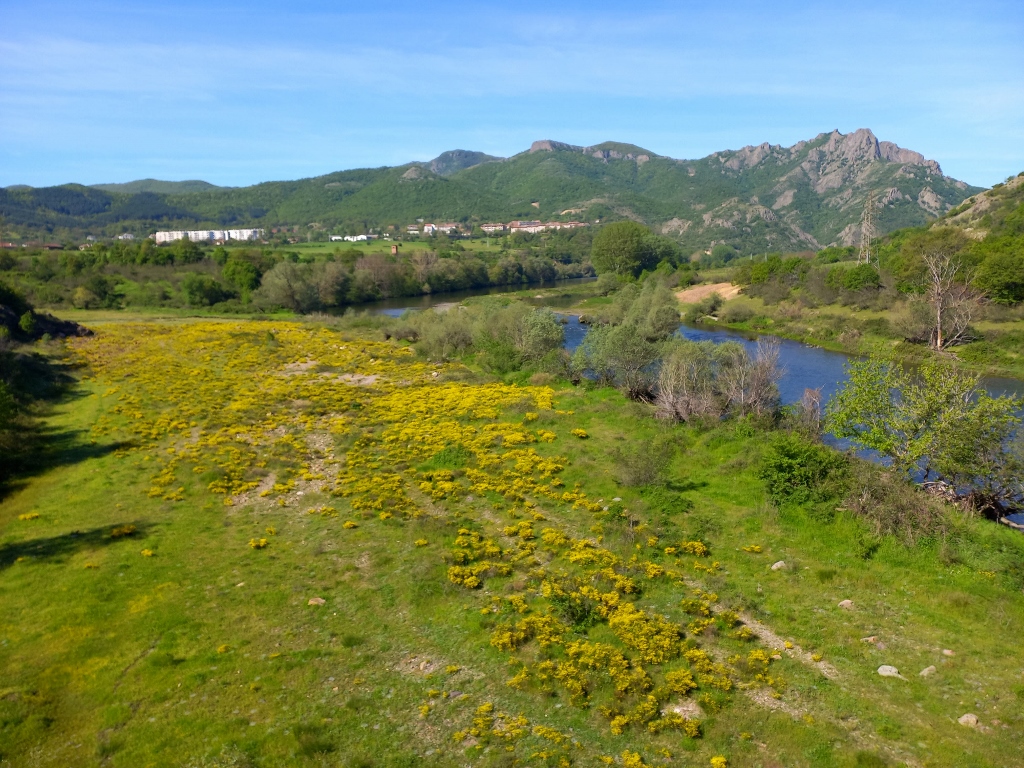 View from the bridge over the Arda river; a little farther there is Madzharovo
View from the bridge over the Arda river; a little farther there is Madzharovo
Then with the group I went a hundred of metres or so from that clearing/parking lot to the Nature Conservation Centre “Eastern Rhodopes.” Namely, this is where the Visitor Centre is which includes an exhibition hall, a souvenir shop, as well as a small hotel and a restaurant.
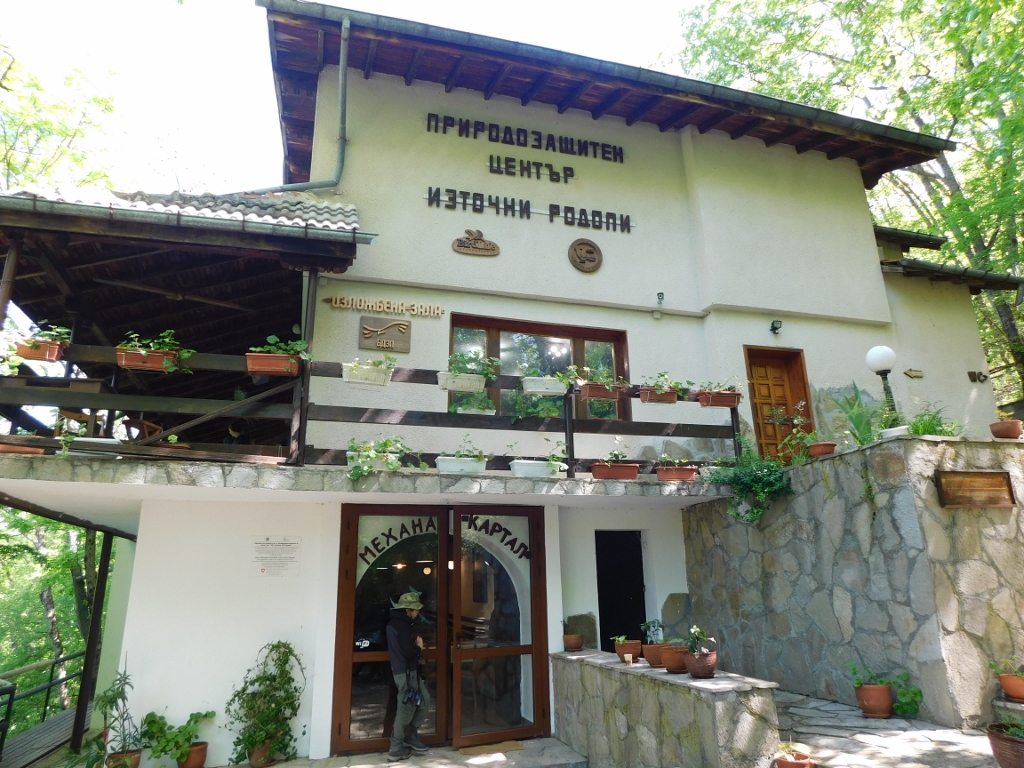 Nature Conservation Centre “Eastern Rhodopes”
Nature Conservation Centre “Eastern Rhodopes”
Some of us took coffee or something else to get refreshed, some went for a short walk and some went up to see the exhibit and the shop before more of us gathered there. Namely, our host, Ivaylo Angelov, told us a little about the work of the centre and primarily about the birds of prey that can be seen here and how various special programmes are implemented.
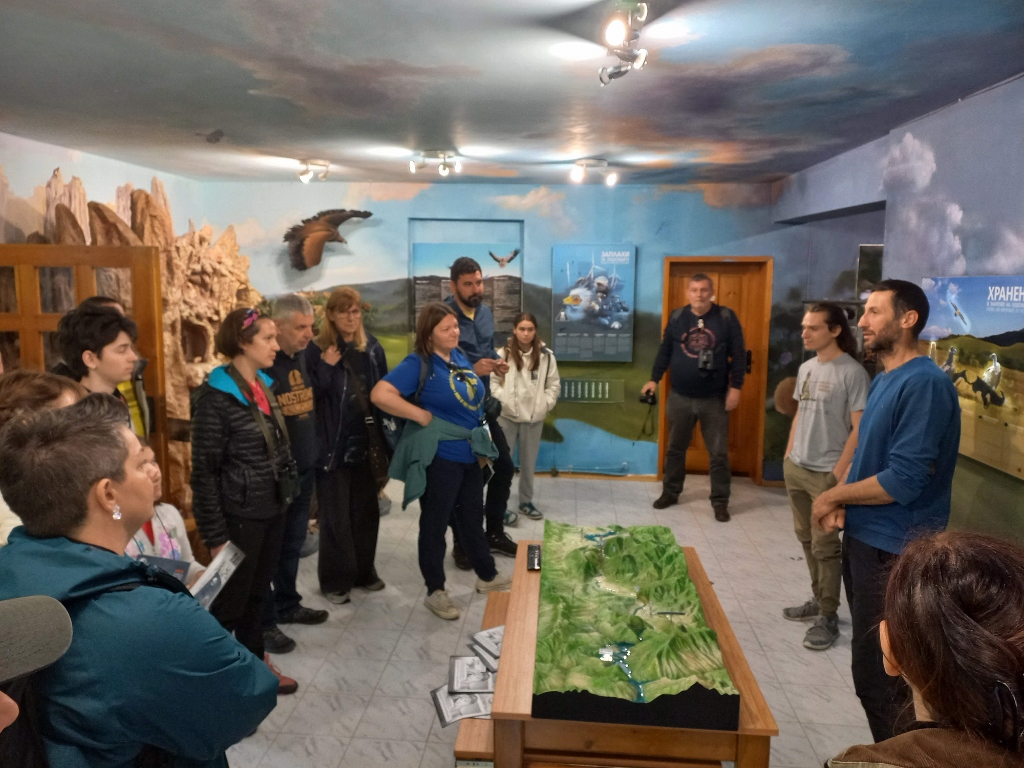 Nature Conservation Centre “Eastern Rhodopes”
Nature Conservation Centre “Eastern Rhodopes”
After this, we all went back to the coach, got in again and then crossing the bridge headed for one renowned viewpoint by the road from where it is possible to look at the horseshoe bend of the Arda river.
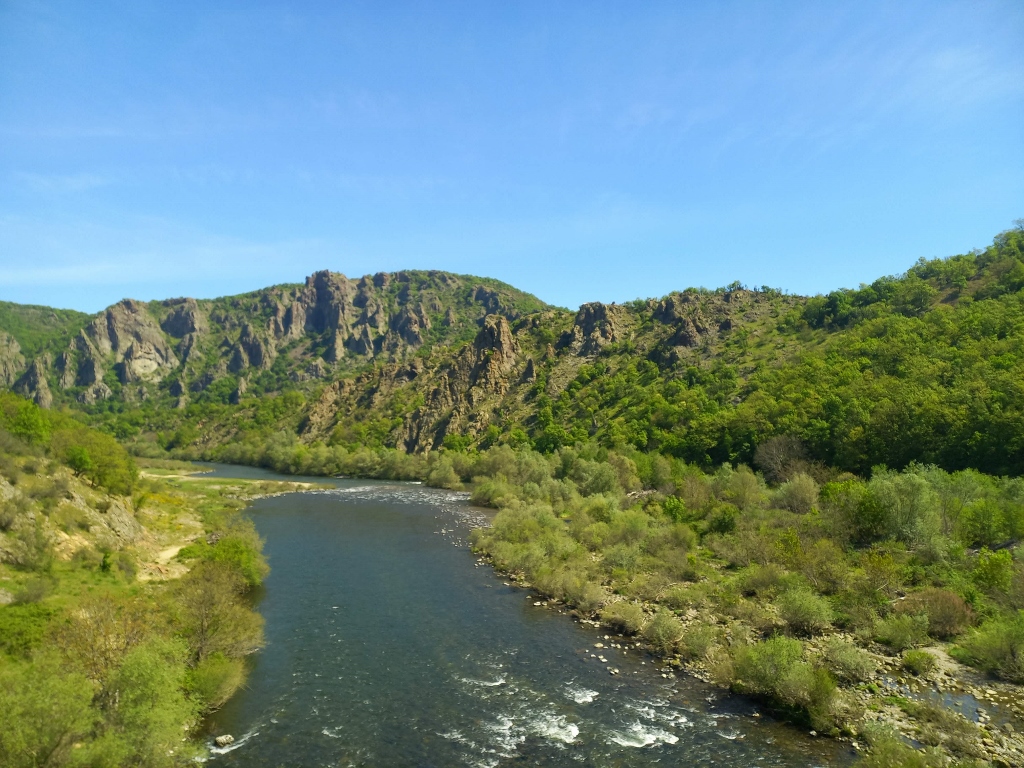 The Arda river seen from the bridge
The Arda river seen from the bridge
As soon as the coach parked and I got out, I went back down the road a little, since I was absolutely delighted by the view at the river and its meander that I could see from the coach.
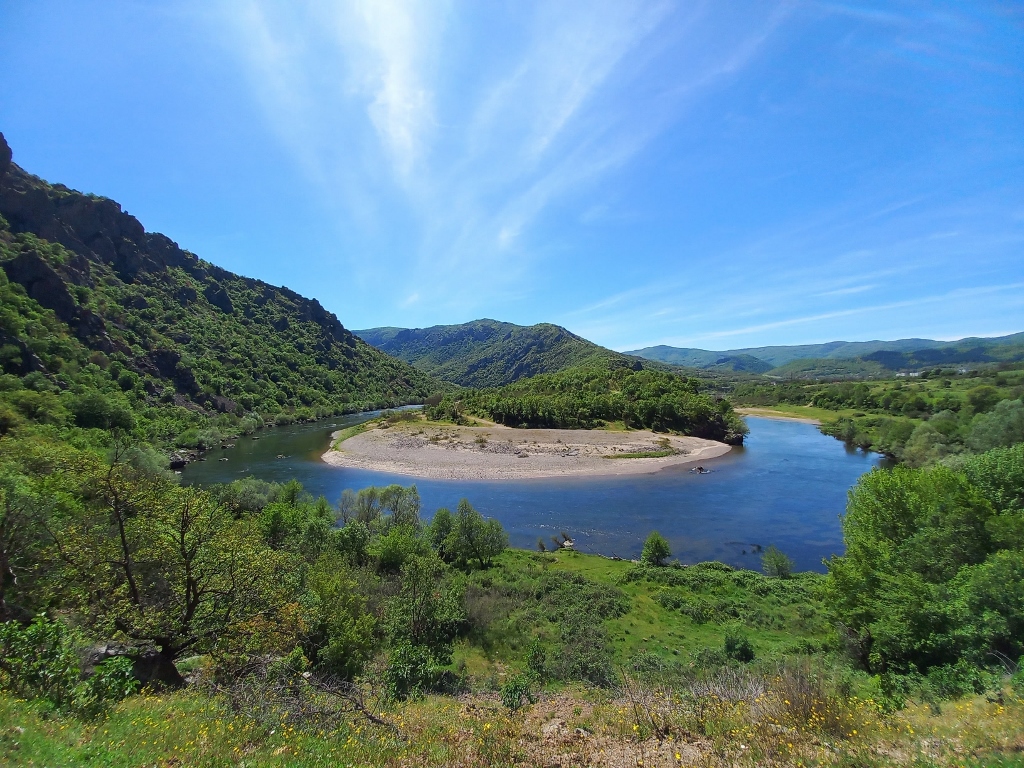 Famous horseshoe bend of the Arda river
Famous horseshoe bend of the Arda river
I thoroughly enjoyed and took some photos there and then I returned towards the coach and the group I was with during this trip.
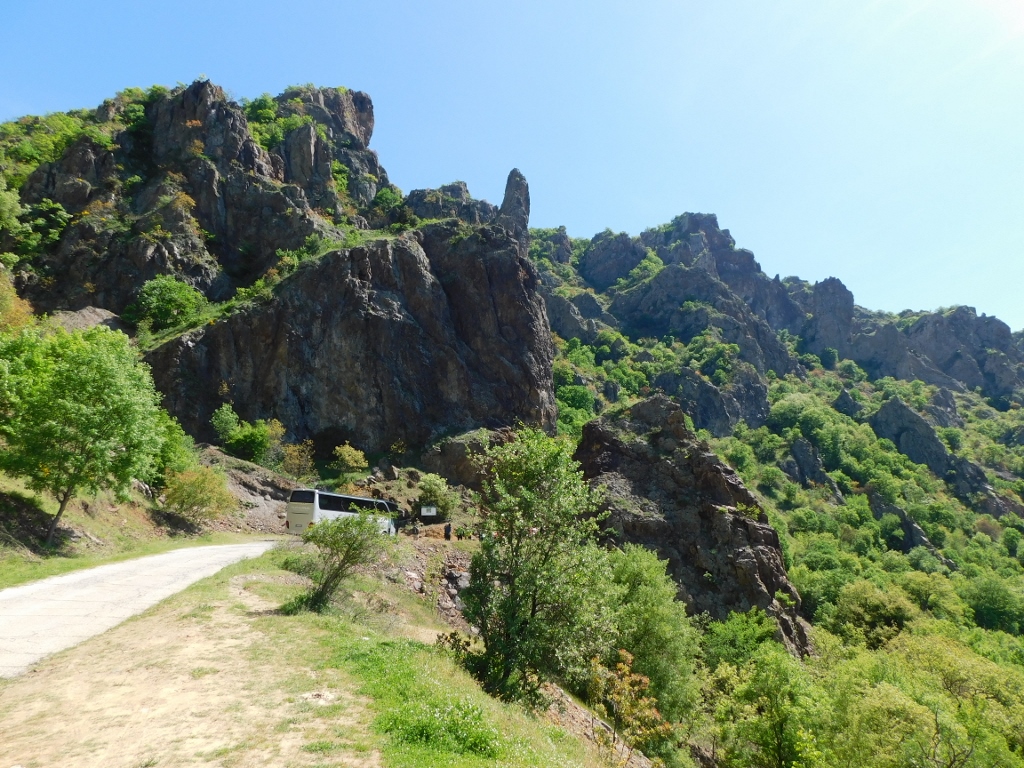 The Arda river valley
The Arda river valley
The view at the Arda meander was also exceptionally stunning from that spot where the group was, so I continued to take photos filled with immeasurable delight.
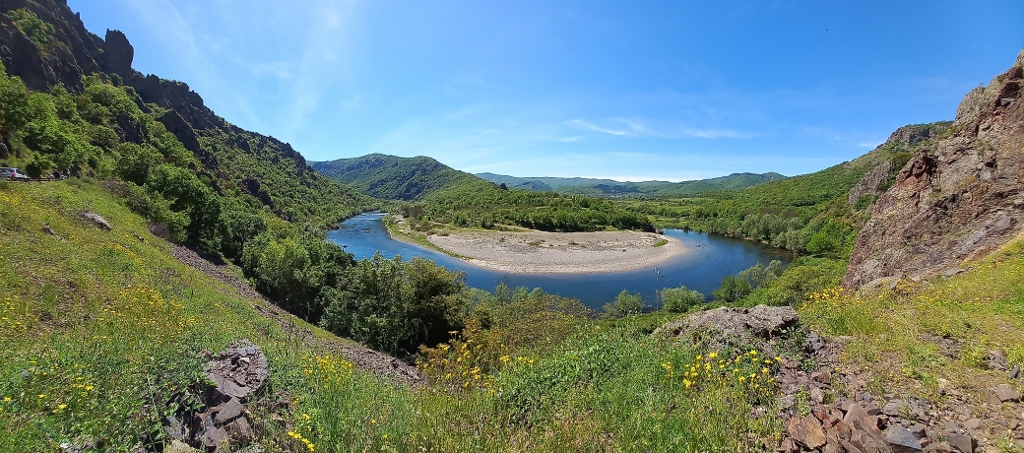 Famous horseshoe bend of the Arda river
Famous horseshoe bend of the Arda river
As far as the group was concerned, well, these were primarily bird lovers and their behaviour was in line with that.
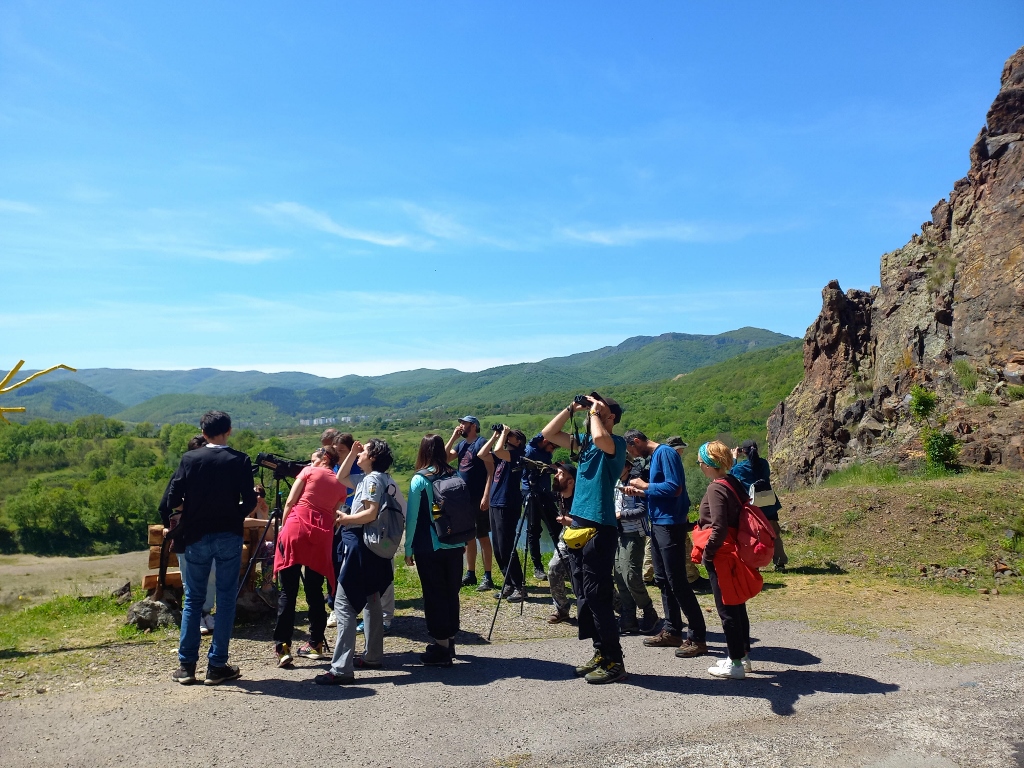 Bird-watchers in the Arda river valley
Bird-watchers in the Arda river valley
And there was plenty to see there. Not only did I see a lot myself, I even managed to take photos of a few birds. Thus, I caught with my photo-camera some Eurasian griffon vultures (Gyps fulvus), a black stork (Ciconia nigra) and an alpine swift (Apus melba).
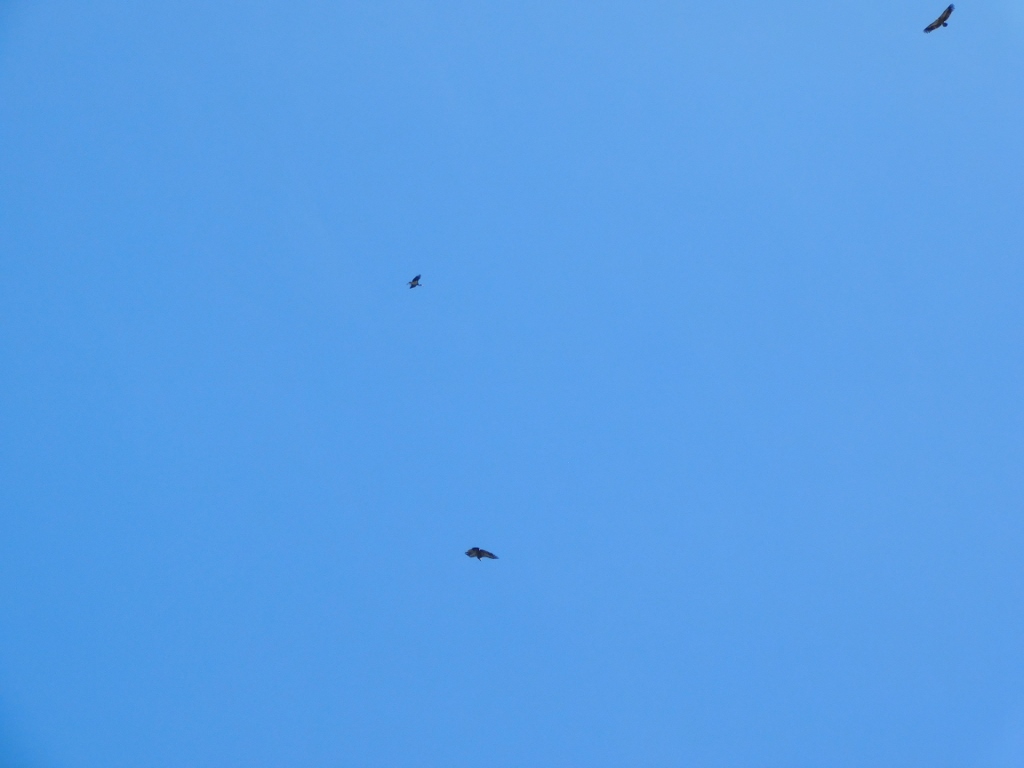 Black stork is in the middle and up, the rest are two griffon vultures
Black stork is in the middle and up, the rest are two griffon vultures
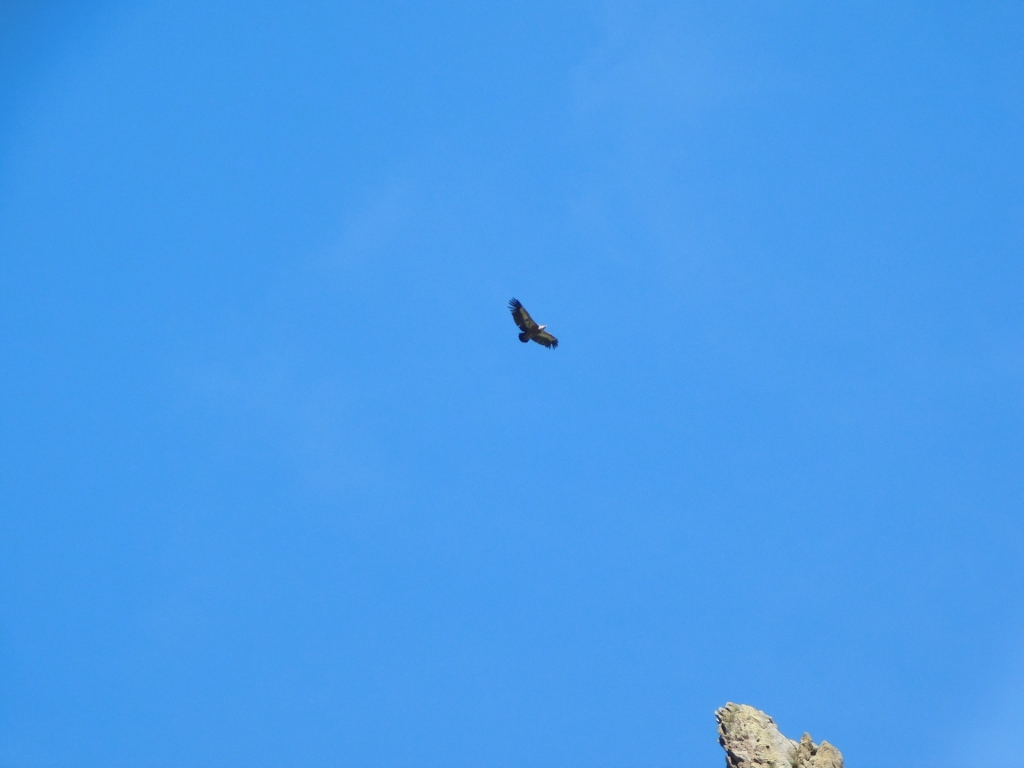 Eurasian griffon vulture
Eurasian griffon vulture
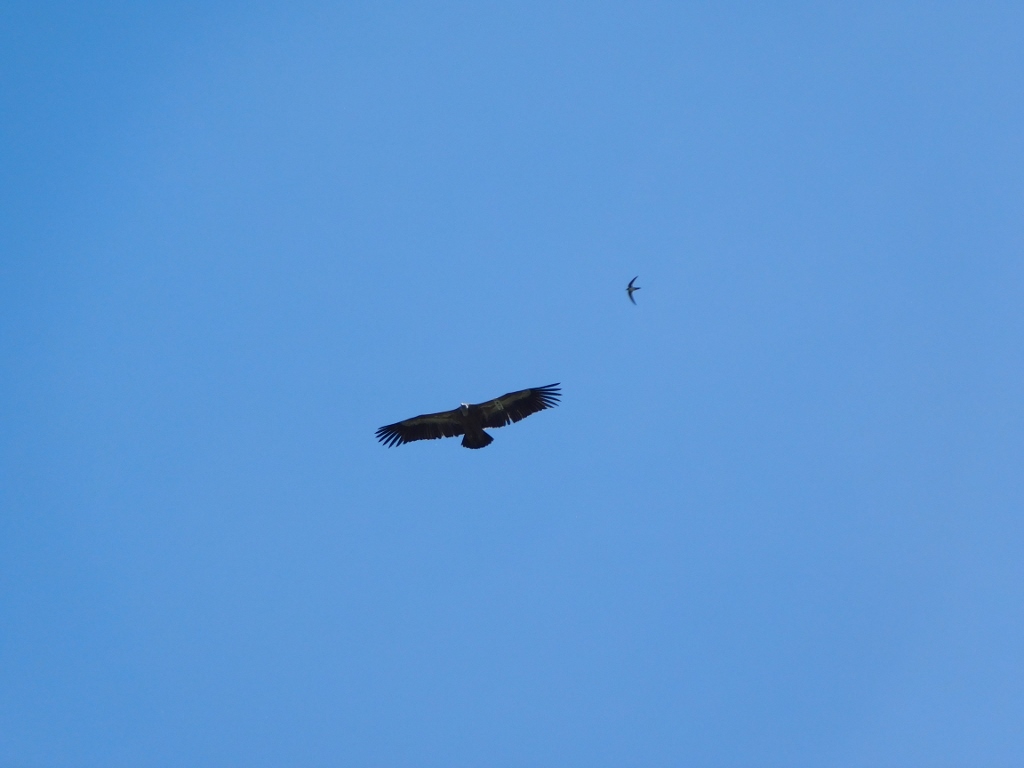 Eurasian griffon vulture and an alpine swift
Eurasian griffon vulture and an alpine swift
Since I was here thanks to the Birds of Prey Protection Foundation (http://vulture.org.rs/), I think it is only fair to focus a little on the Eurasian griffon vulture.
The Eurasian griffon vulture is one of the biggest birds of prey in Europe. The adults can reach the length of 1.2 m, while their wingspan can be as much as 2.8 m. As for their weight, the maximum weight both in males and females can go almost to 11 kg.
The vultures, including certainly griffon vultures, are famous for having a very high stomach acidity which helps neutralise the dangerous microorganisms from the carrion they feed on. This acid can dissolve not only bones, but also metal.
Although these birds are called the birds of prey, they actually do not hunt at all either domestic or wild animals, rather they feed exclusively on carcasses. This is exceptionally beneficial, for in this way any spreading of the diseases is prevented and this constitutes the natural way to solve the issue of “biological waste.” In other words – Ladies and gentlemen, if you want to have a 100% natural recycling of dead ruminants (as well as other, selected types of mammals), you should bring the vultures back into their natural habitats!
By the way, a major problem has arisen in India over the recent decades as regards the seriously declining numbers of vultures there. Namely, vultures are particularly important for the Parsis, an ethnic community the members of which moved in the 8th century from Persia to western India, specifically to the area around present-day Mumbai. I will not go into the details regarding their religion, but what is important for this story is the fact that the Parsis do not bury their dead, but rather leave them on the specially built platforms in order for the vultures to eat the carcasses. As this is becoming a major issue on account of the insufficiency in the numbers of vultures, I proposed to Saša [Marinković] that we should start business by organising transfer of the dead bodies of the Parsis to the feeding site for the griffon vultures. I don’t think he took me seriously at all, which I guess is just as well.
I have already talked about griffon vultures on several occasions since I find them particularly interesting bearing in mind that their recovery in Serbia is the result of the great programmes implemented precisely by the “Birds of Prey Protection Foundation.” In other words, my travel stories contain several texts where griffon vultures are mentioned and one of the first is the following: https://www.svudapodji.com/en/birds-2/.
As for this stay in Greece and Bulgaria in the spring of 2023, the group also included some members who were more interested in plants, such as Šemija and a little girl.
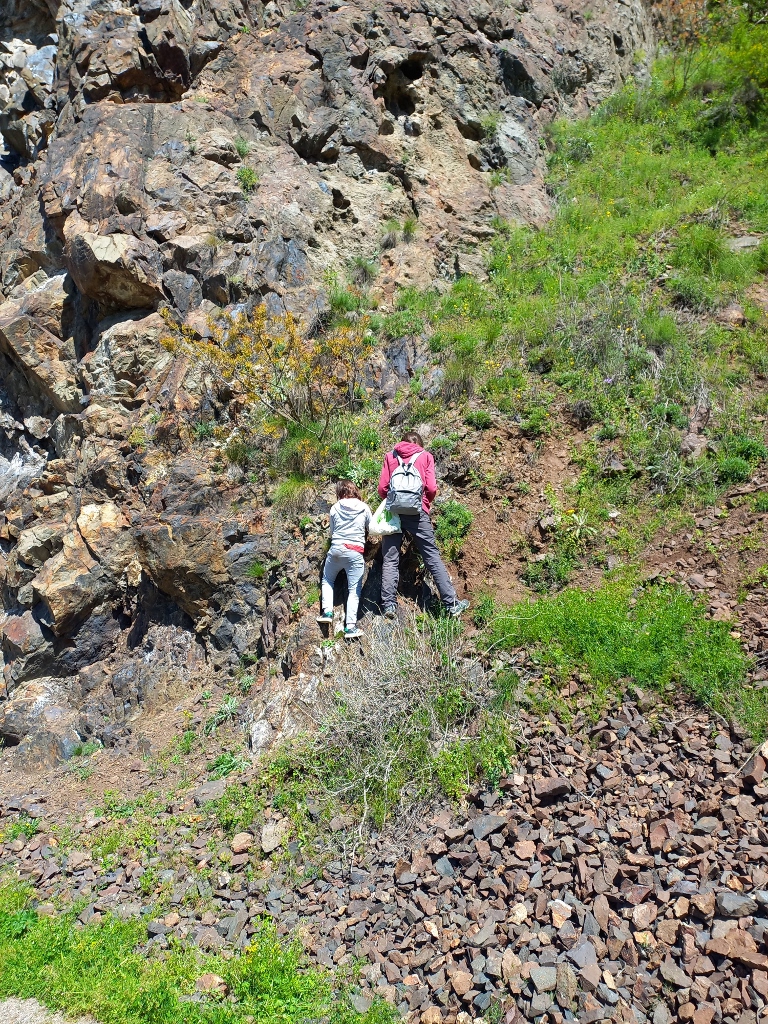 Studying plants in the Arda river valley
Studying plants in the Arda river valley
I was also interested in the plants, but more as a decoration in the photos I kept taking primarily delighted by the entire nature I was surrounded with.
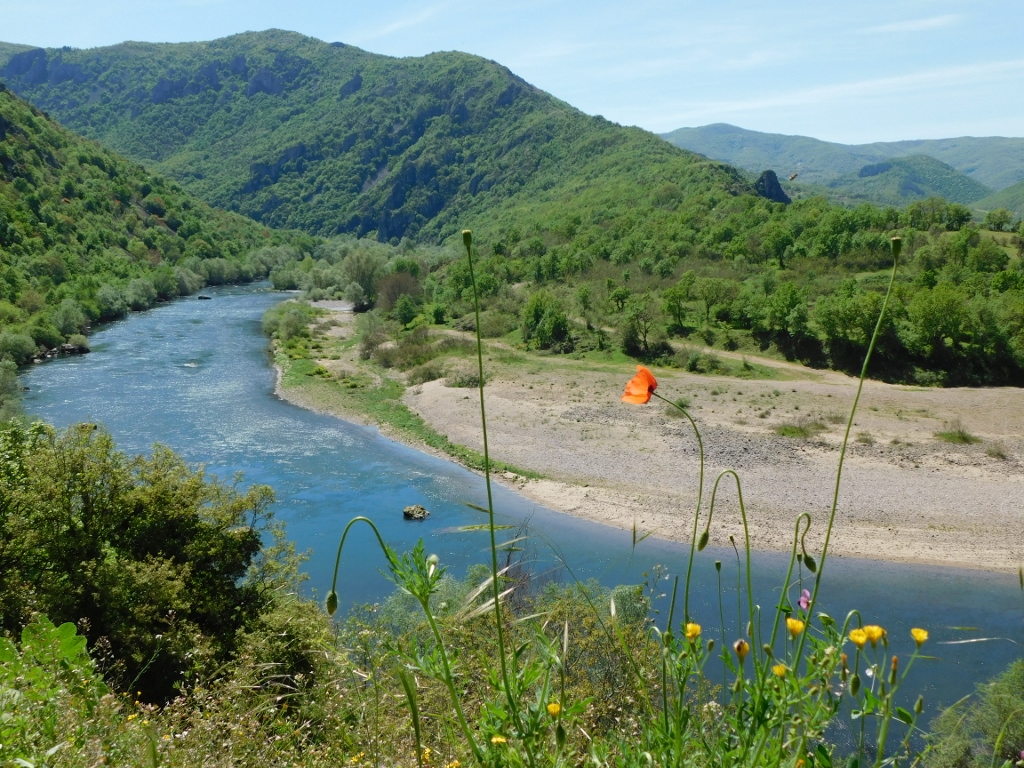 The Arda river valley
The Arda river valley
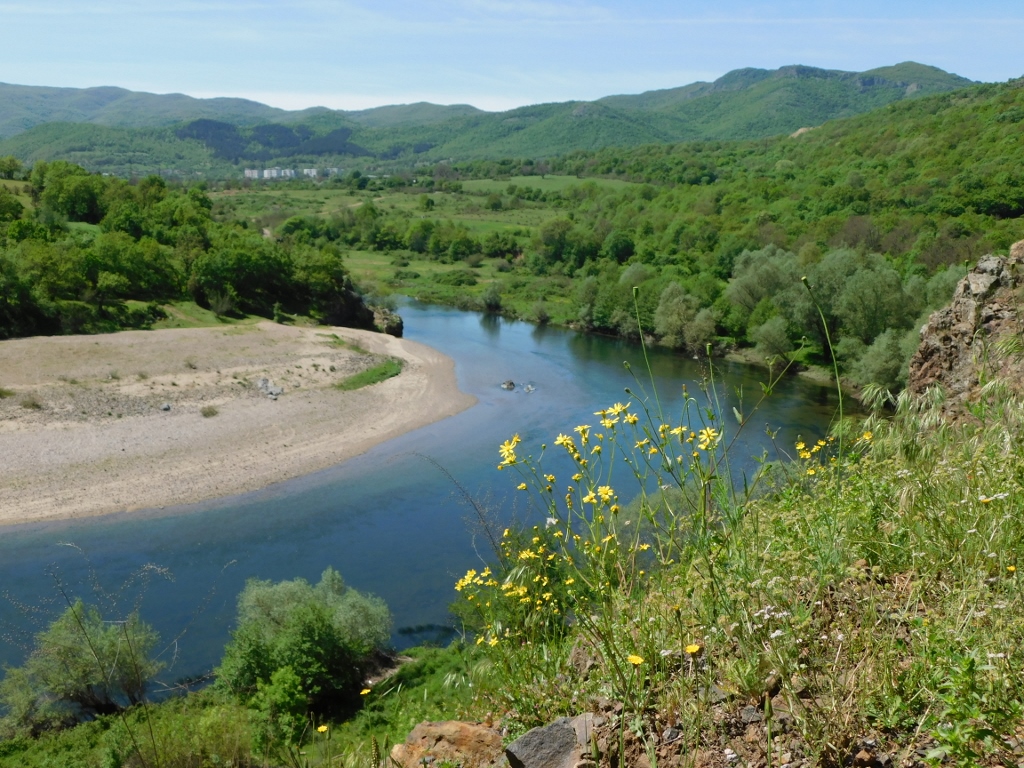 The Arda river valley
The Arda river valley
And then I spotted a perfect stone that lured me into sitting there. I did not actually meditate, but I certainly enjoyed the spectacular view I had from there trying to calm my mind and open up for the sensations.
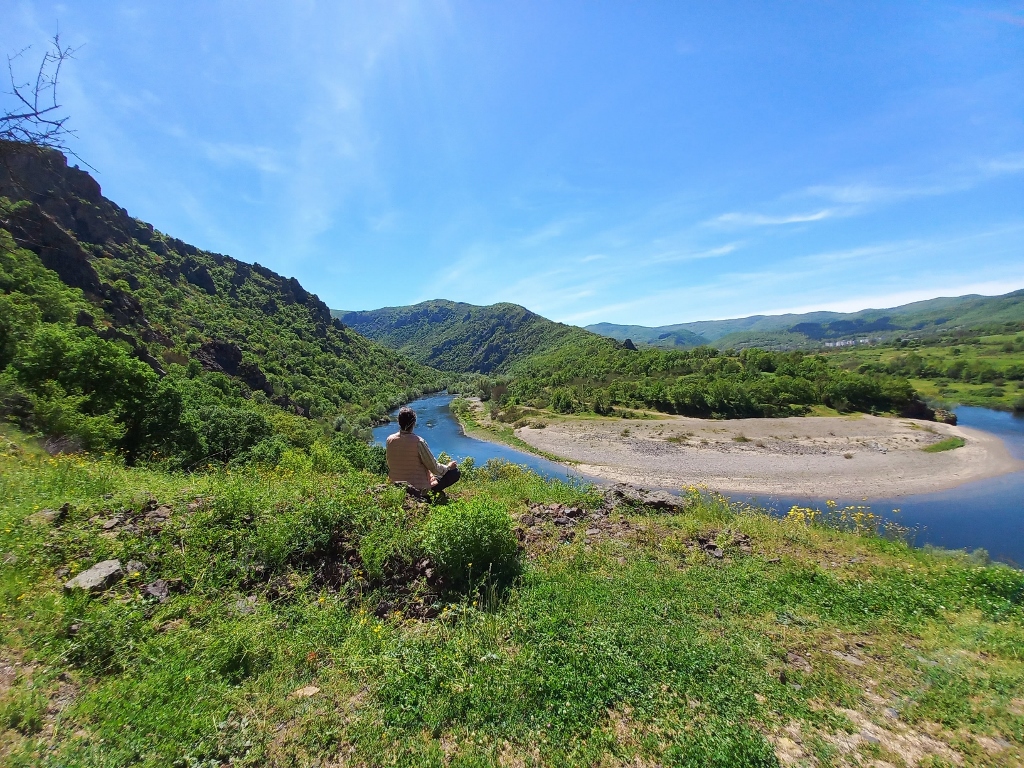 Moments of calm and bliss in the Arda river valley
Moments of calm and bliss in the Arda river valley
After a while, I got up and went back to “being with people,” but I still often looked at the whole area and the sky. Thus I noticed a very interesting turn by an airplane that was leaving a trace behind.
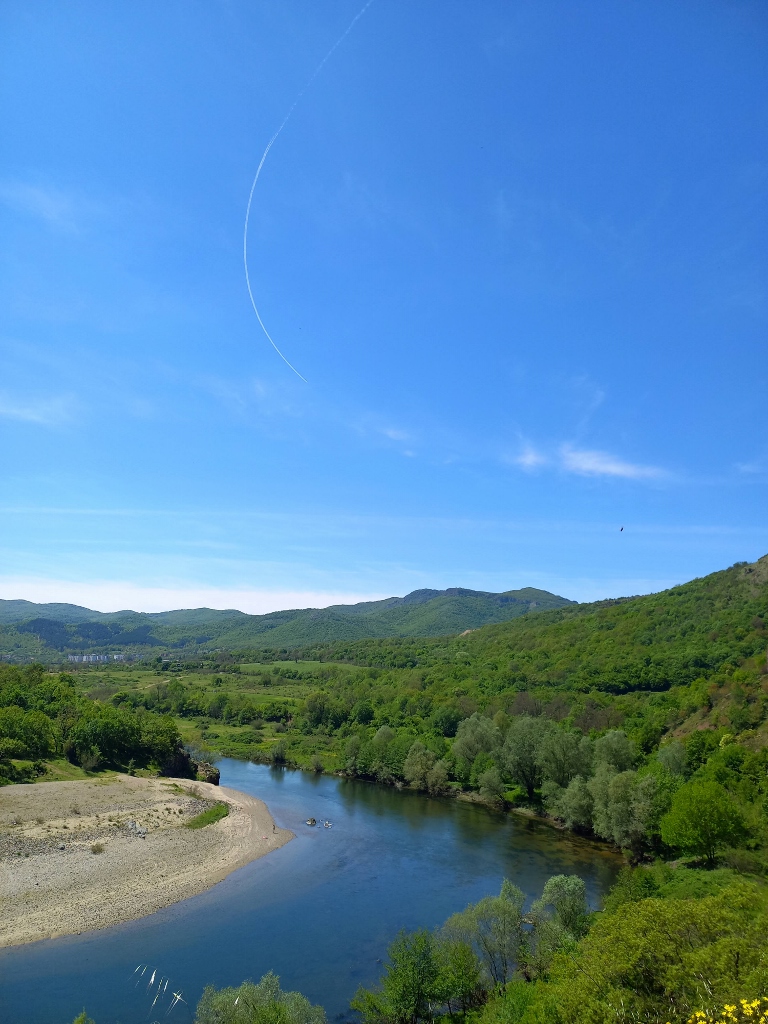 Sky above the Arda river
Sky above the Arda river
A couple of people from the group drew my attention to several Eurasian crag martins or just crag martins from the swallow family (Ptyonoprogne rupestris) that had their nests in the rocks beside the road. With a lot of patience, I even managed to take a couple of photos of them.
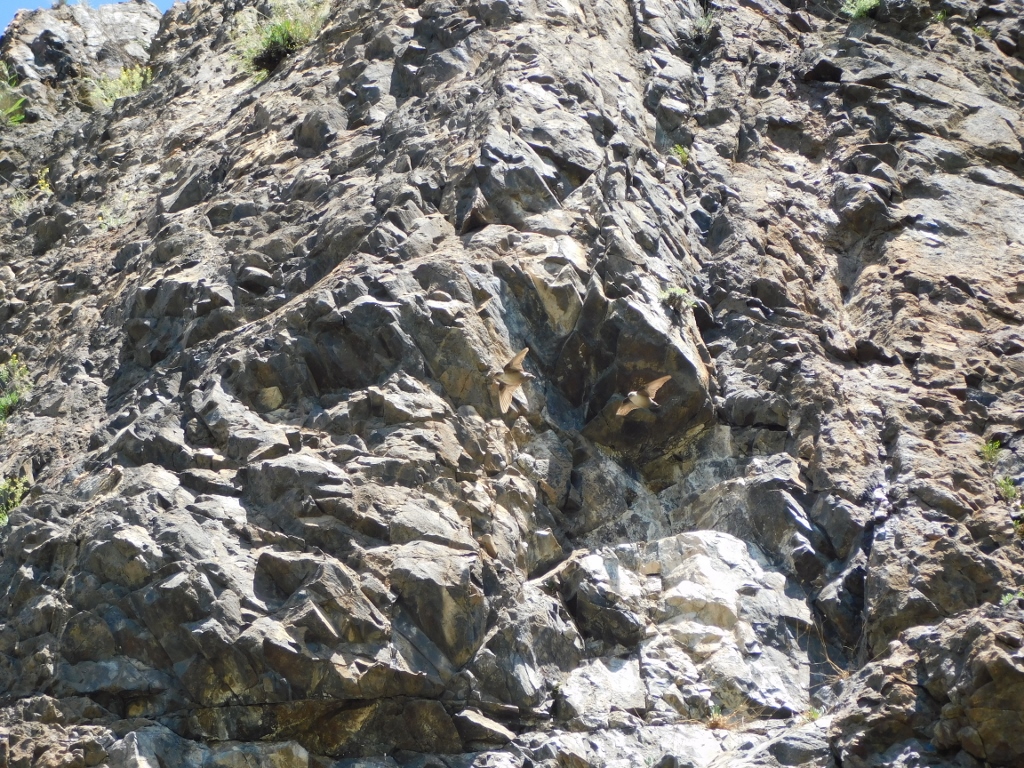 A couple of crag martins in mid-flight
A couple of crag martins in mid-flight
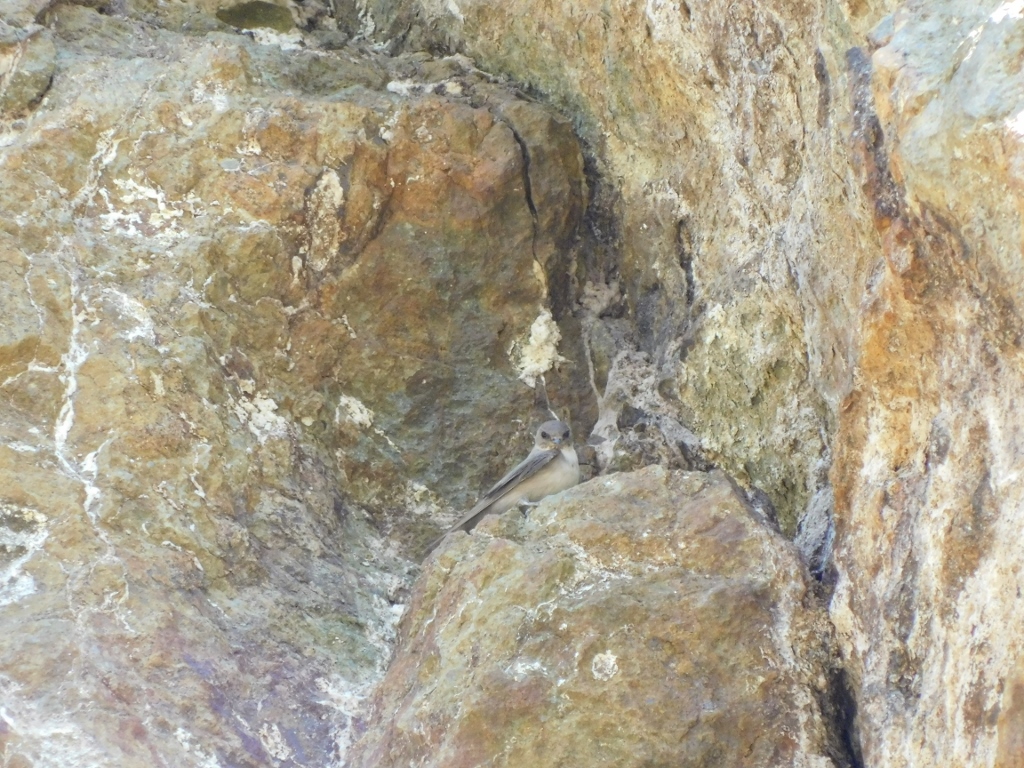 Crag martin and I mutually staring at each other
Crag martin and I mutually staring at each other
And then there was no more time for watching birds, so we parted from our hosts, got into the coach again and headed back for Serbia.
At the beginning of this travel story I mentioned that I had already been in Bulgaria on a couple of occasions, but both times very briefly. However, I do not remember many details of these trips. Now, I was exceptionally impressed by the splendid landscapes that can be seen in this country. For a number of years now I’ve been having Bulgaria in mind as a destination for a longer journey and what I could see this time from the coach only strengthened this idea.
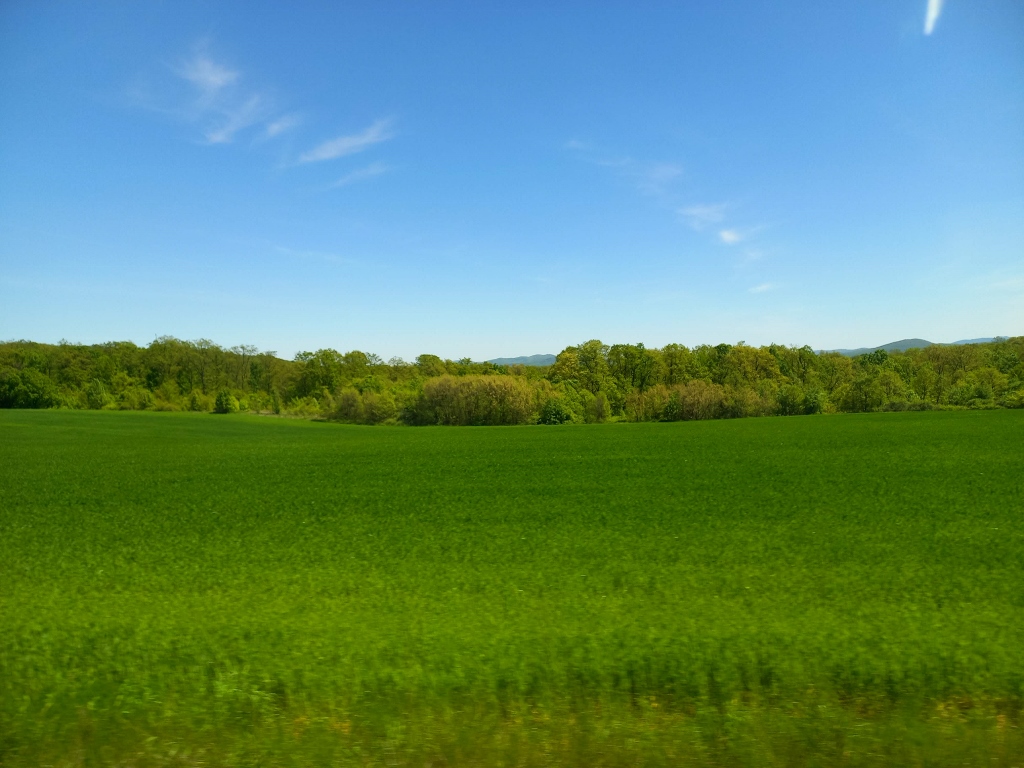 Landscapes in south Bulgaria
Landscapes in south Bulgaria
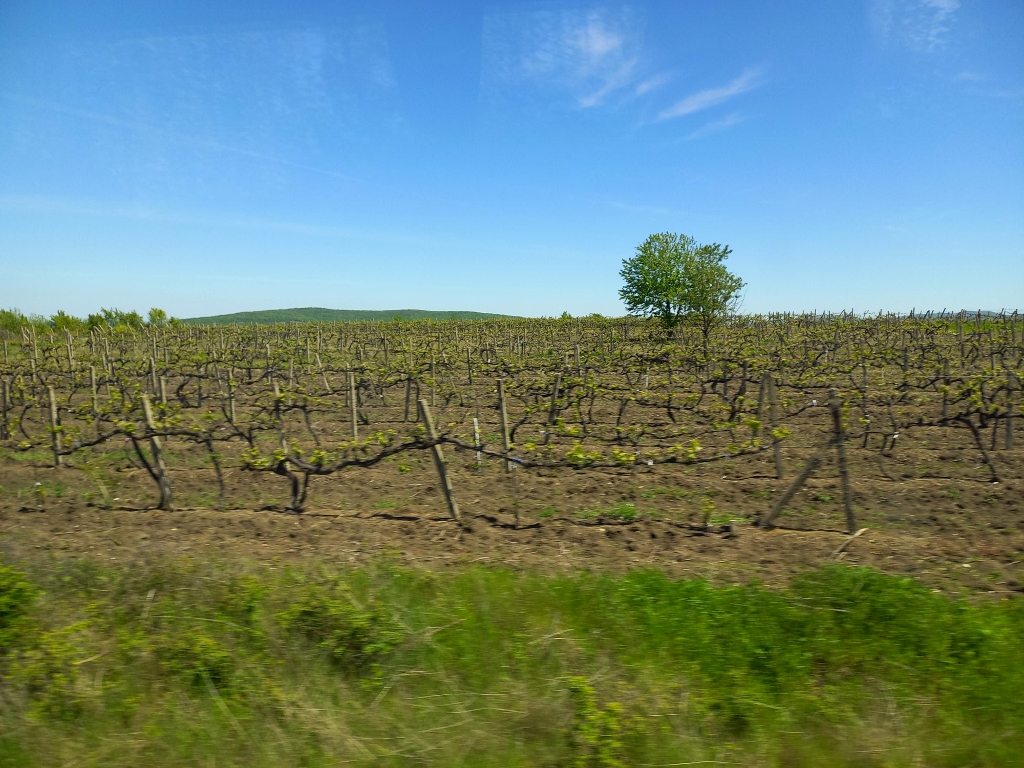 Landscapes in south Bulgaria
Landscapes in south Bulgaria
Since we had a long journey back to Belgrade ahead of us, we made a stop in Haskovo where a restaurant was recommended to us and indeed the food was great. After all, the Bulgarians and the Serbs have a similar taste when it comes to food.
Then we reached a motorway that led us further to the west, towards Sofia and on, towards the border with Serbia. Along the way, in the distance, I could see the snow-capped summits of Bulgarian Stara Planina (there is a Stara Planina in Serbia as well), which is a part of the Balkan mountain range.
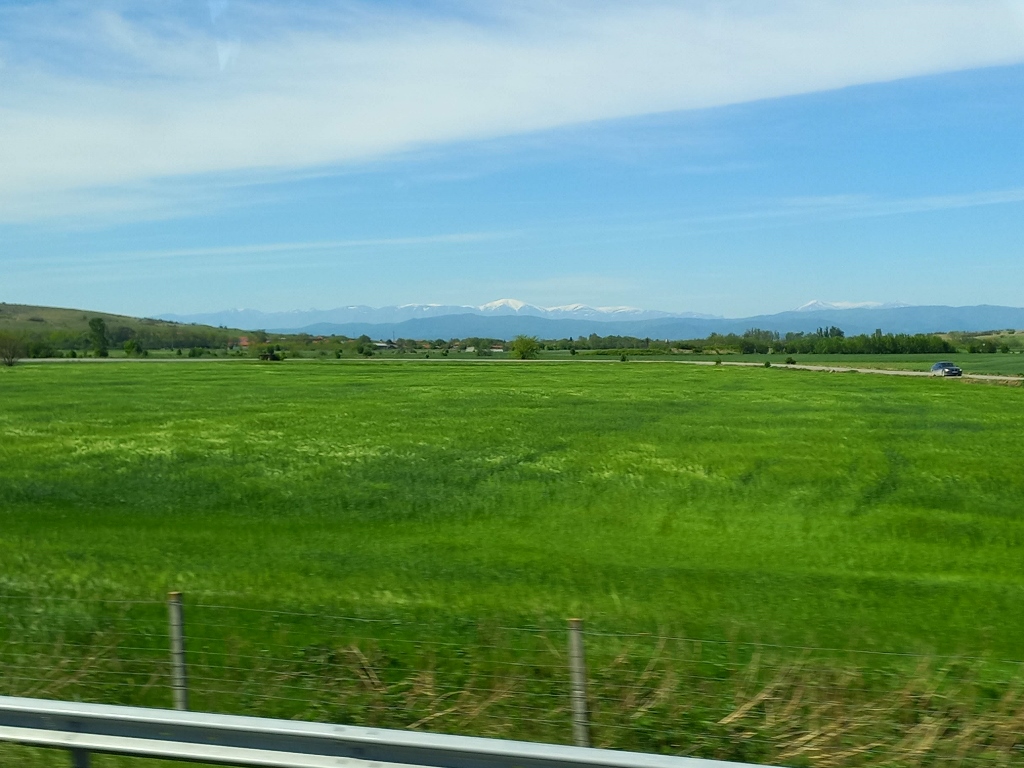 Landscapes in central Bulgaria
Landscapes in central Bulgaria
When we got to the Bulgarian-Serbian border it was almost night-time. Once in Serbia, we made a couple of breaks, first for toilet and soon for dinner as well. However, I was delighted with the toilet. Obviously, not because of itself, but because in a corner of the ceiling I could see a nest and a barn swallow (Hirundo rustica) in it. I was actually delighted by what a woman working there told me and that was that the staff had realised that swallows made nests in several spots there and so the people did not destroy the nests during winters when the swallows fly away to warmer climates. When the swallows return, they find their last-year homes waiting for them. I think this is very nice.
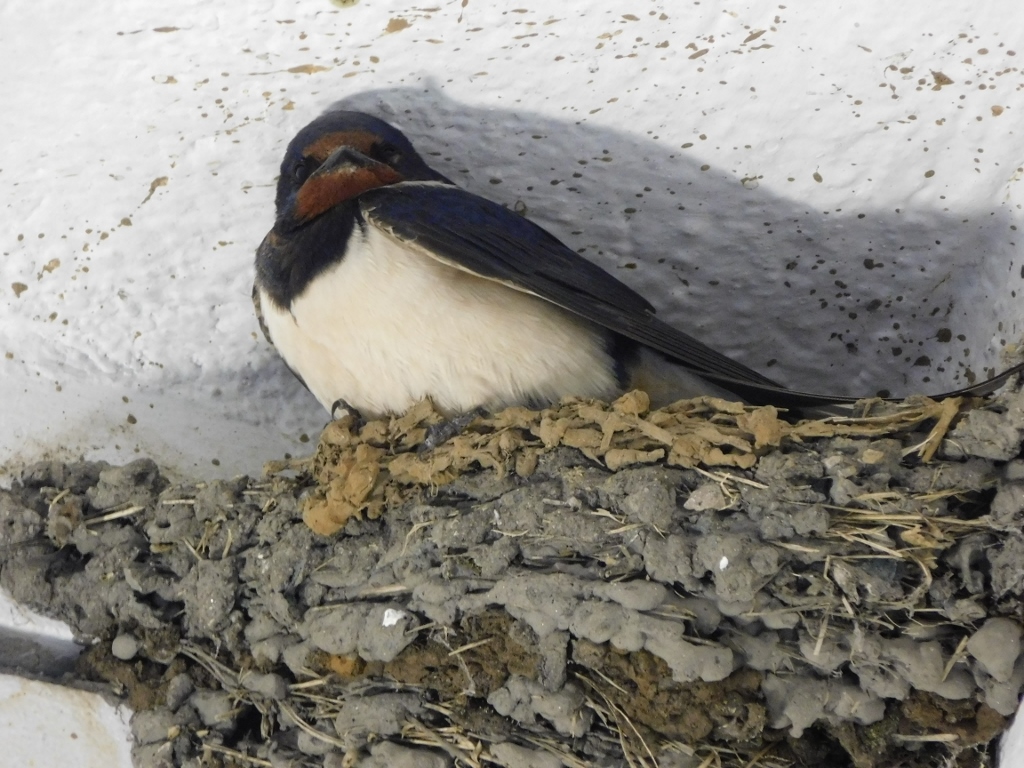 Barn swallow
Barn swallow
There were also many barn swallows at the restaurant near the border where we made the break for dinner, but by this time the light was rather weak and I could not make a decent photo, plus I didn’t want to use flash in order not to disturb them (the shadow in the photo above comes from the lighting at the toilet). Or maybe I was just tired.
In any case, after the dinner we continued with the trip and later, around midnight, after many adventures and wonderful experiences, we got back to Belgrade. I was rather tired, but also exceptionally content.
Here is the map that shows the places we visited during this trip: